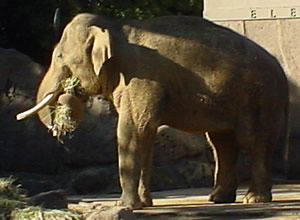|
Elephas
Elephas adalah salah satu dari dua genera dalam famili gajah, Proboscidea. Di dalam genus ini hanya terdapat satu spesies yang belum punah, yaitu gajah asia Elephas maximus.[1]
Beberapa spesies yang telah punah telah dikategorikan ke dalam genus ini, seperti Elephas recki, Elephas antiquus, serta gajah kerdil E. falconeri dan E. cypriotes. Genus ini berhubungan erat dengan genus Mammuthus.[2]
Taksonomi
Elephas tergolong dalam famili Elephantidae dan terdiri dari 10 spesies (baik yang masih ada maupun yang sudah punah):[3]
Referensi
- ^ a b Shoshani, J. (2005). "Order Proboscidea". Dalam Wilson, D. E.; Reeder, D. M. Mammal Species of the World (edisi ke-3rd). Johns Hopkins University Press. hlm. 90. ISBN 978-0-8018-8221-0. OCLC 62265494.
- ^ Fleischer, R. C.; Perry, E. A.; Muralidharan, K.; Stevens, E. E.; Wemmer, C. M. (2001). Phylogeography of the Asian Elephant (Elephas maximus) based on mitochondrial DNA Diarsipkan 2012-03-17 di Wayback Machine.. Evolution 55(9): 1882–1892
- ^ a b Maglio, V.J. (1973). Origin and evolution of the Elephantidae. Transactions of the American Philosophical Society Philadelphia Volume 63. American Philosophical Society, Philadelphia. Hlm. 149
- ^ Fernando, P., Vidya, T.N.C., Payne, J., Stuewe, M., Davison, G., et al. (2003). DNA Analysis Indicates That Asian Elephants Are Native to Borneo and Are Therefore a High Priority for Conservation. PLoS Biol 1 (1): e6
- ^ Von Königswald, G.H.R. (1956). Fossil mammals from the Philippines. National Research Council of the Philippines, Manila
- ^ Hooijer, D.A. (1949). Pleistocene Vertebrates from Celebes. IV. - Archidiskodon celebensis nov spec.. Zoologische Mededelingen Museum Leiden, 30 (14): 205–226.
- ^ Busk, G. (1867). Description of the remains of three extinct species of elephant, collected by Capt. Spratt, C.B.R.N., in the ossiferous cavern of Zebbug, in the island of Malta. Transactions of the Zoological Society of London, 6: 227–306.
- ^ Falconer, H. Cautley, P. T. (1846). Fauna Antiqua Sivalensis, Being the Fossil Zoology of the Sewalik Hills. Smith, Elder & Company, London. Pp. 64.
- ^ Hooijer, D. A. (1955). Fossil Proboscidea from the Malay Archipelago and the Punjab. Zoologische Verhandelingen, 28 (1): 1–146.
- ^ Todd, N. E. (2001). African Elephas recki: Time, space and taxonomy. In: Cavarretta, G., Gioia, P., Mussi, M. and M. R. Palombo. The World of Elephants, Proceedings of the 1st International Congress. Consiglio Nazionale delle Ricerche, Rome, pp. 693–697.
- ^ Todd, N. E. (2005). Reanalysis of African Elephas recki: Implications for time, space and taxonomy. Quaternary International 126–128: 65–72.
|
|
